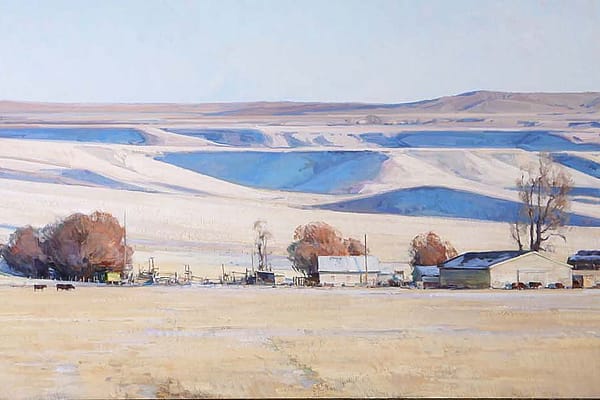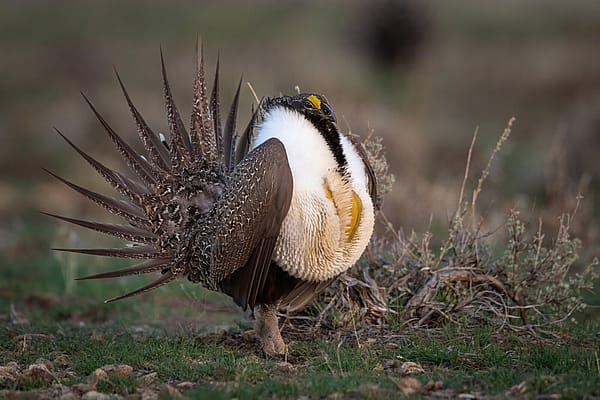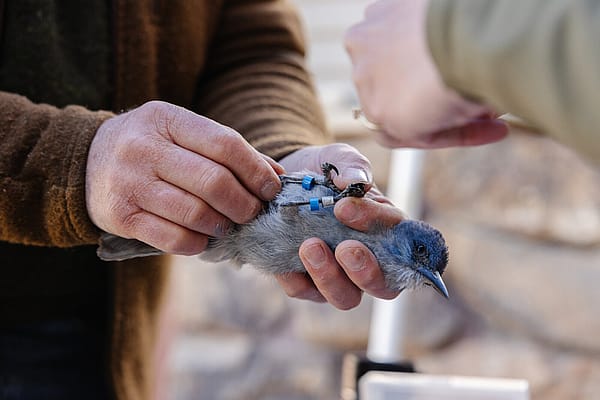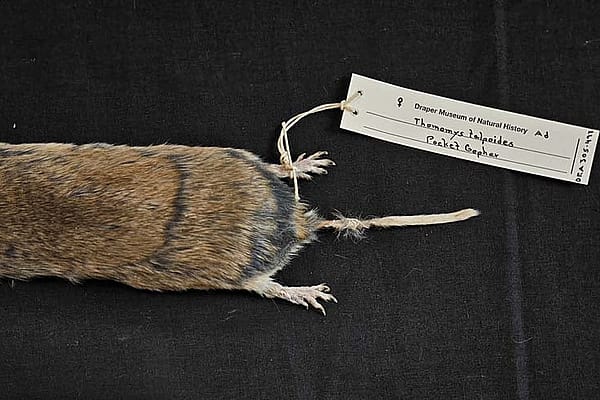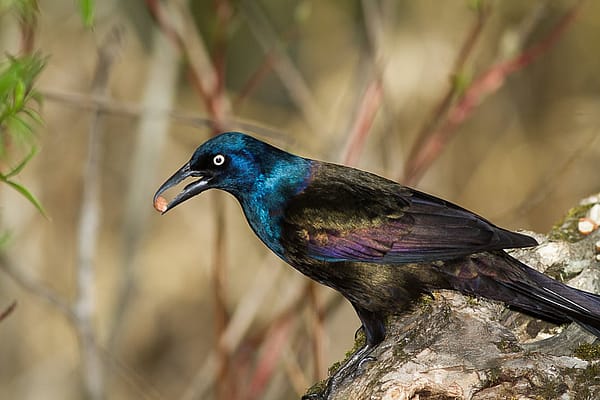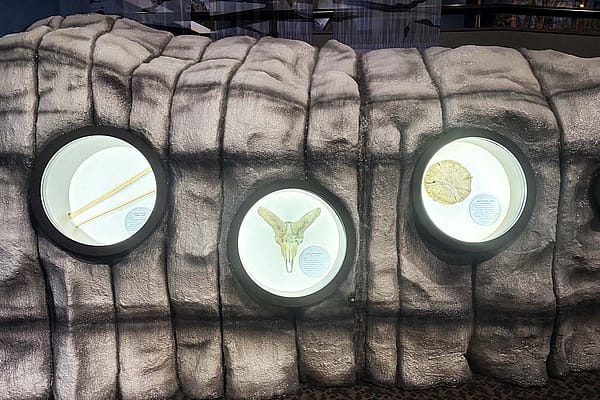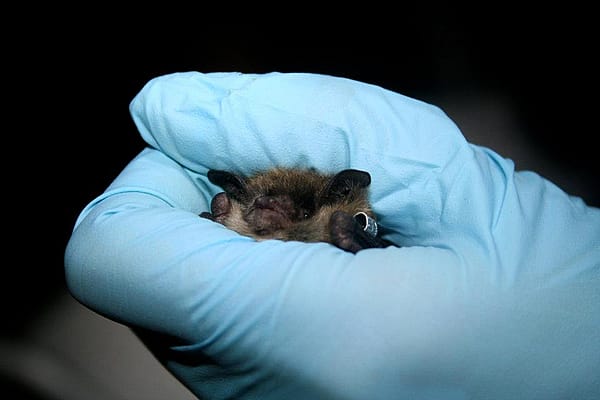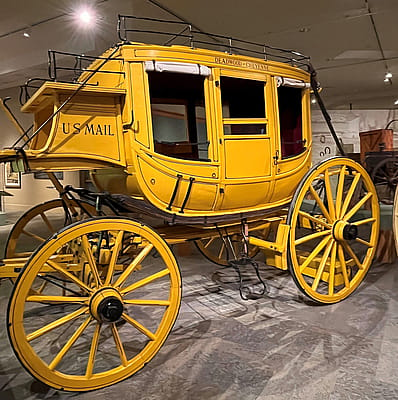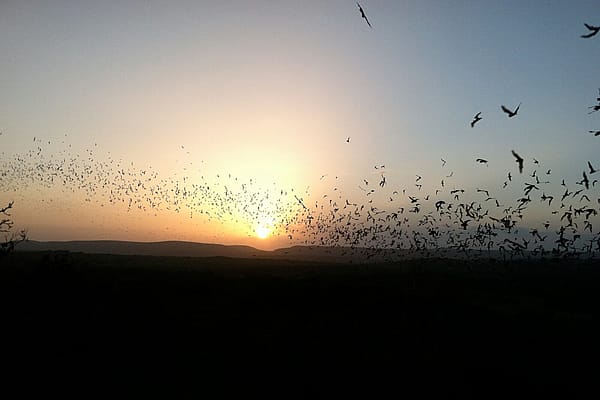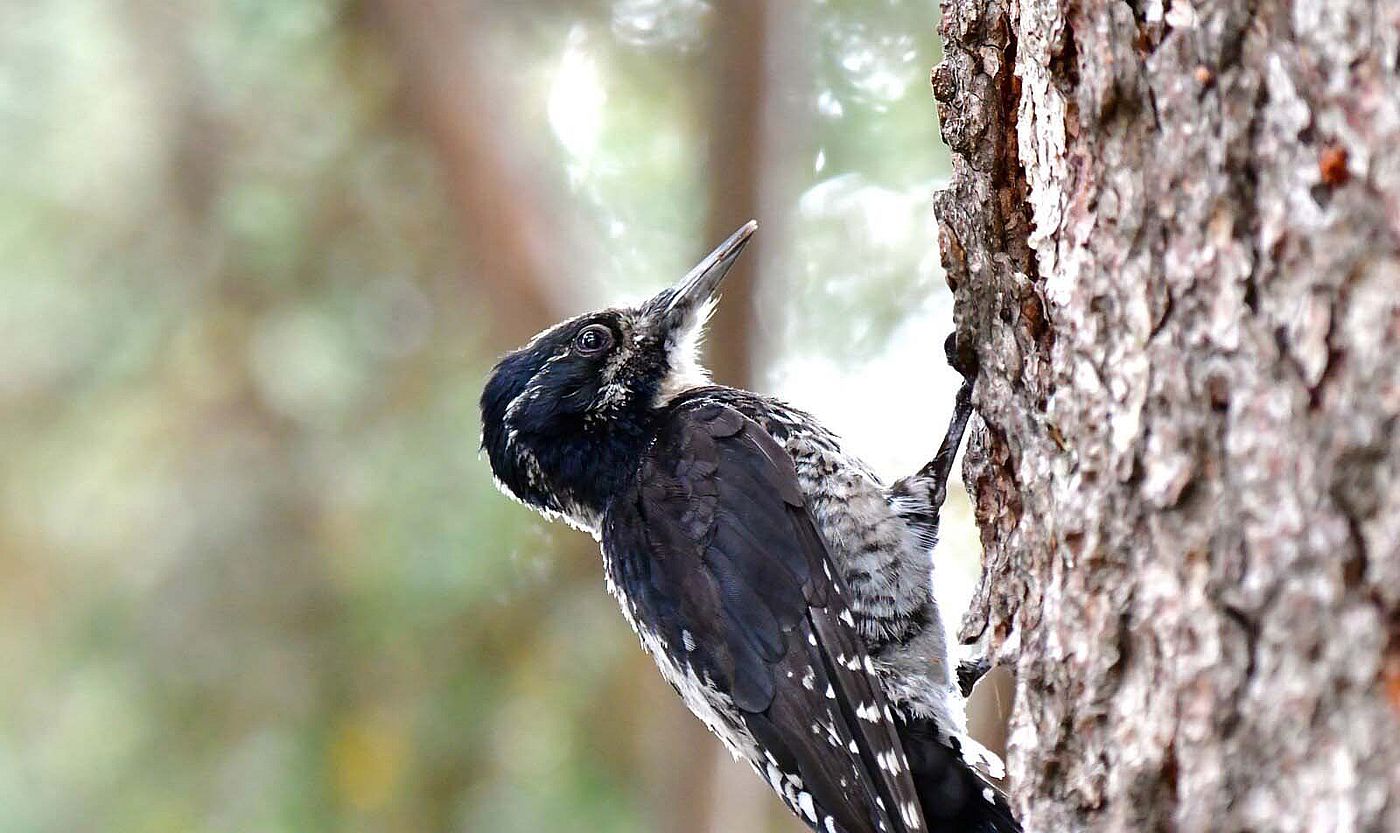
Woodpeckers of the Greater Yellowstone Ecosystem
The variety of habitats within the Greater Yellowstone Ecosystem makes it a perfect place for many species of woodpeckers. Eight of these species are present throughout the summer while others, like the Pileated Woodpecker, only appear occasionally. Woodpeckers, part of the family Picidae, communicate by drumming on trees with their bills, which produces a loud noise that echoes through forested areas. Most woodpeckers feed on insects and other invertebrates. While these species seem very similar, they all play different roles in helping the ecosystem thrive.
Northern Flicker
The Northern Flicker is one of the easiest of the woodpecker species in the Greater Yellowstone Ecosystem to identify. Much of the flicker’s plumage is reddish-brown or gray. They have a black bib and small spots on their front. The underside of their barred wings is a vivid red-orange color in western North America or yellow in the East. Red-shafted Northern Flickers have a bright red mark extending down beneath the eye from the opening of the bill. Another unique marking on flickers is the bright white mark at the base of their tail, typically visible in flight.
Flickers will often climb trees vertically like other woodpeckers and nest in cavities as well, but they tend to eat on the ground. They often forage near American Robins, pulling ants and beetles from the dirt with their specialized tongues. Flickers visit backyards in areas with many trees, calling and drumming loudly. Cornell Lab’s All About Birds website mentions a Northern Flicker in Wyoming whose drumming could be heard from a half-mile away. It was drumming on a tractor.
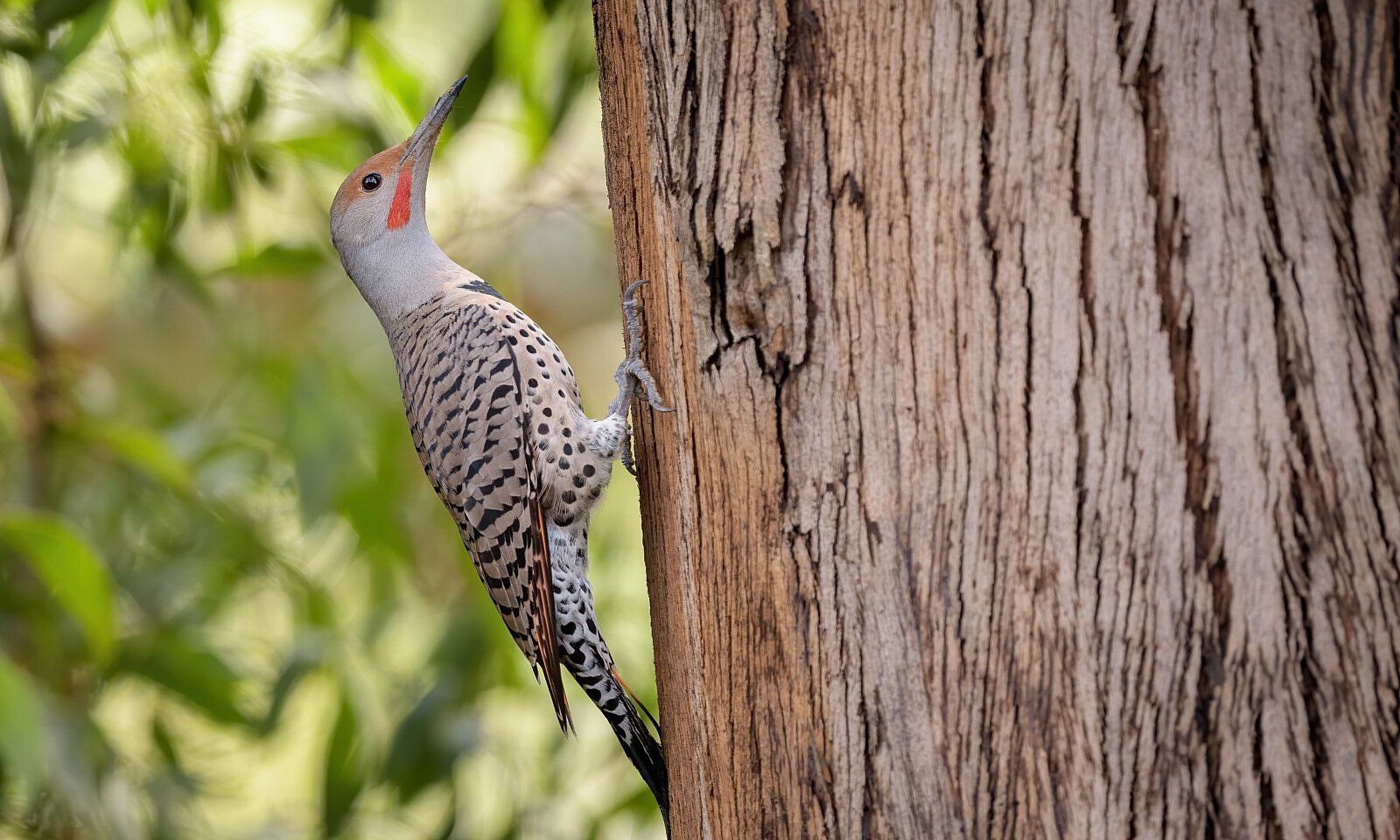
Downy Woodpecker
The Downy Woodpecker is a small bird and is widespread in North America. Its front is white or light brown, but its wings are black with white spots. This woodpecker has a black crown and multiple black stripes on its face. Juveniles have a red cap and adult males have a red nape.
Downy Woodpeckers visit feeders and are particularly interested in suet. In winter, they will forage with flocks of chickadees and nuthatches. Downy Woodpeckers usually search for insects in tree bark, but also will find larvae in the stems of tall weeds. They supplement their diet with plant material like fruit and nuts.
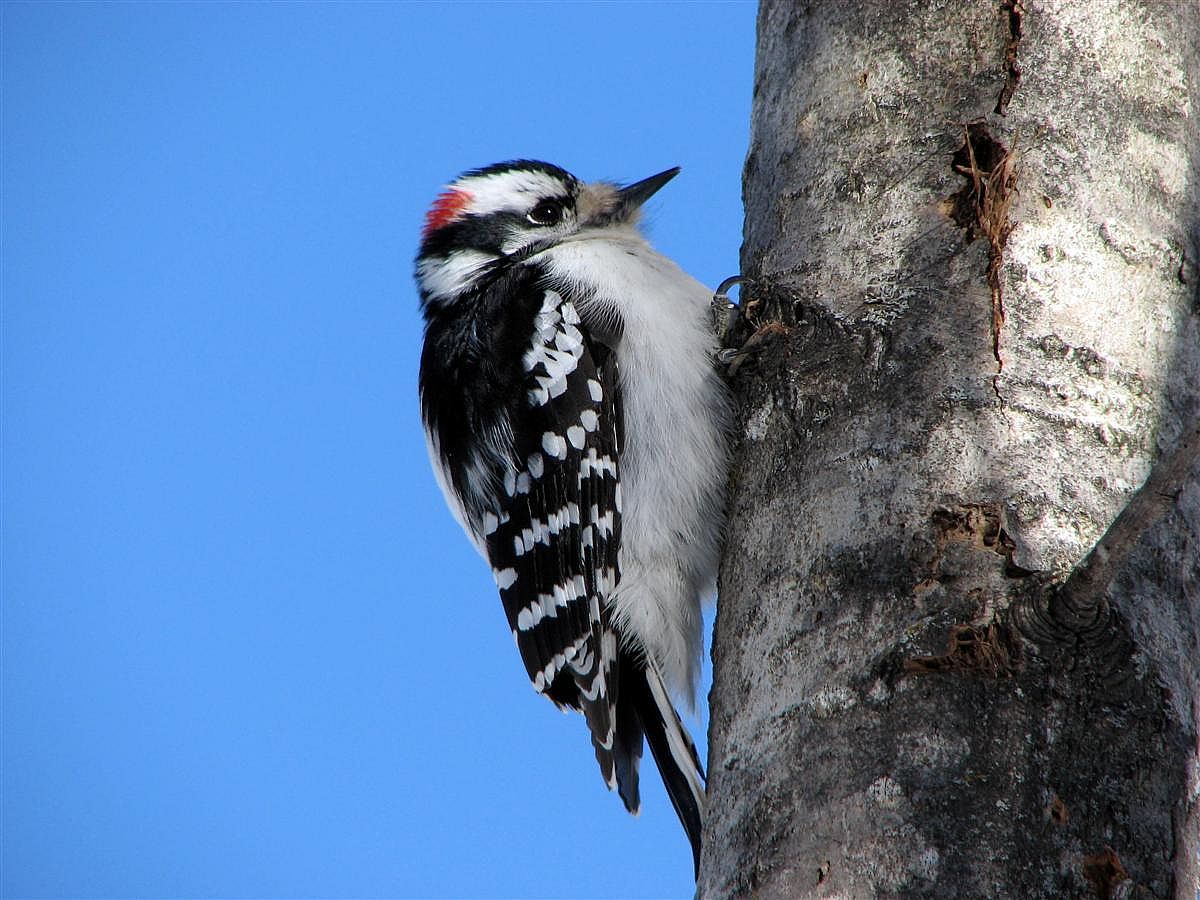
Hairy Woodpecker
Hairy Woodpeckers are very similar to Downy Woodpeckers, and not just visually. Their main difference is size, with the Hairy considerably larger than the Downy. The Hairy Woodpecker also has a longer bill and lacks spots on its white outer tail feathers.
Like Downy Woodpeckers, Hairy Woodpeckers will visit feeders. They also will wait until Pileated Woodpeckers are done excavating trees and search for the insects they miss. Hairy woodpeckers sometimes drink sap from sapsuckers’ wells.
Hairy Woodpeckers will visit almost any habitat with trees and, like other woodpeckers, help control pests. They have a similar diet to Downy Woodpeckers.
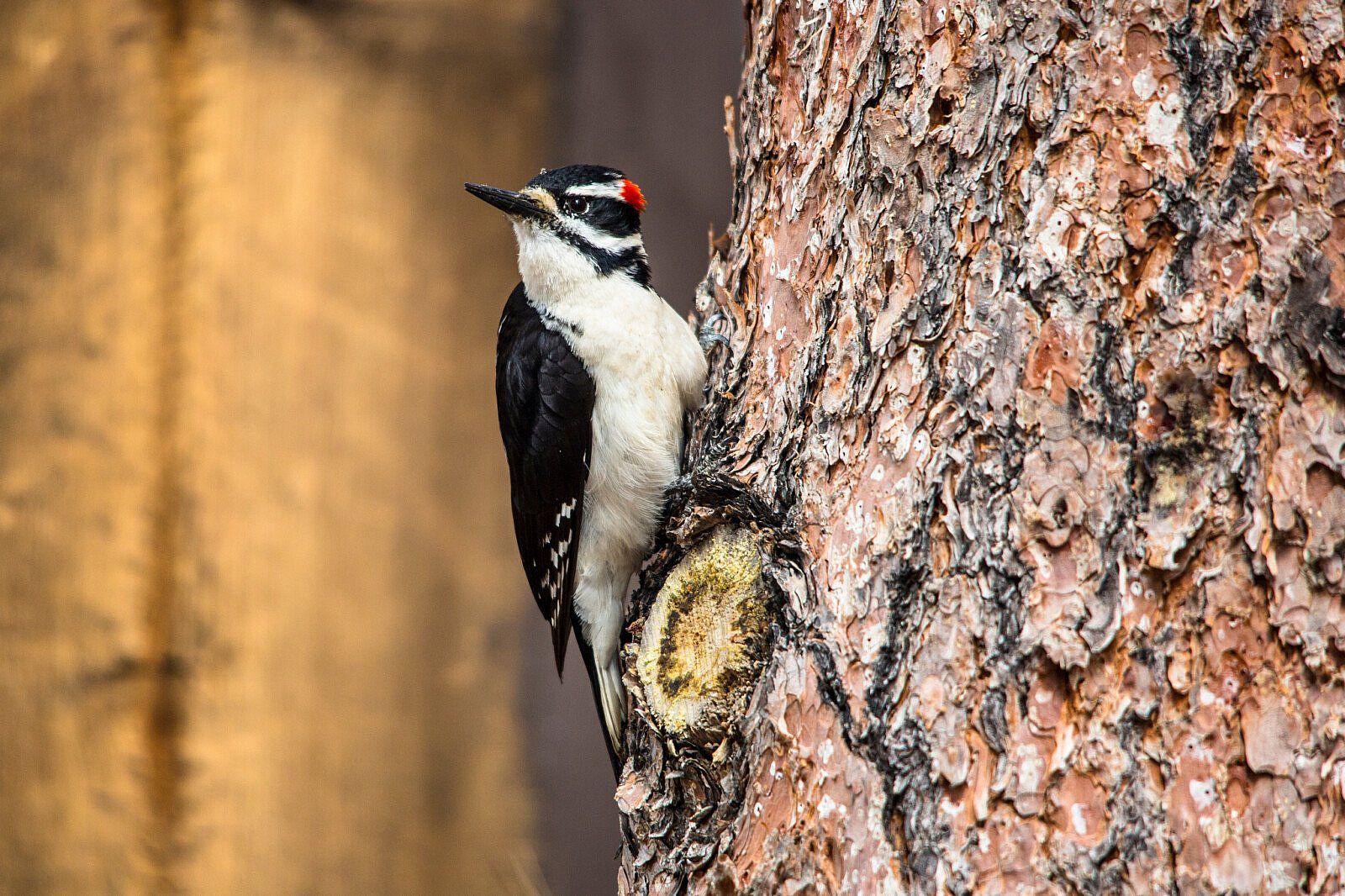
American Three-toed Woodpecker
The American Three-toed Woodpecker lives mainly in coniferous forests, encompassing much of the Greater Yellowstone Ecosystem. It has black and white barring on its sides and back, bordered by dark wings and tail. Males have a yellow crown. Above and below the eye, this woodpecker has white stripes. Its throat is also white.
The American Three-Toed Woodpecker is seen more frequently in the mountains than at lower elevations. It prefers bogs and burnt areas where it can forage on dead trees. It uses its bill to pull bark from trees so that it can access insect larvae.
This bird is one of only three woodpecker species to have just three toes. Before 2003, the American and Eurasian populations of Three-toed Woodpeckers were classified as one species.
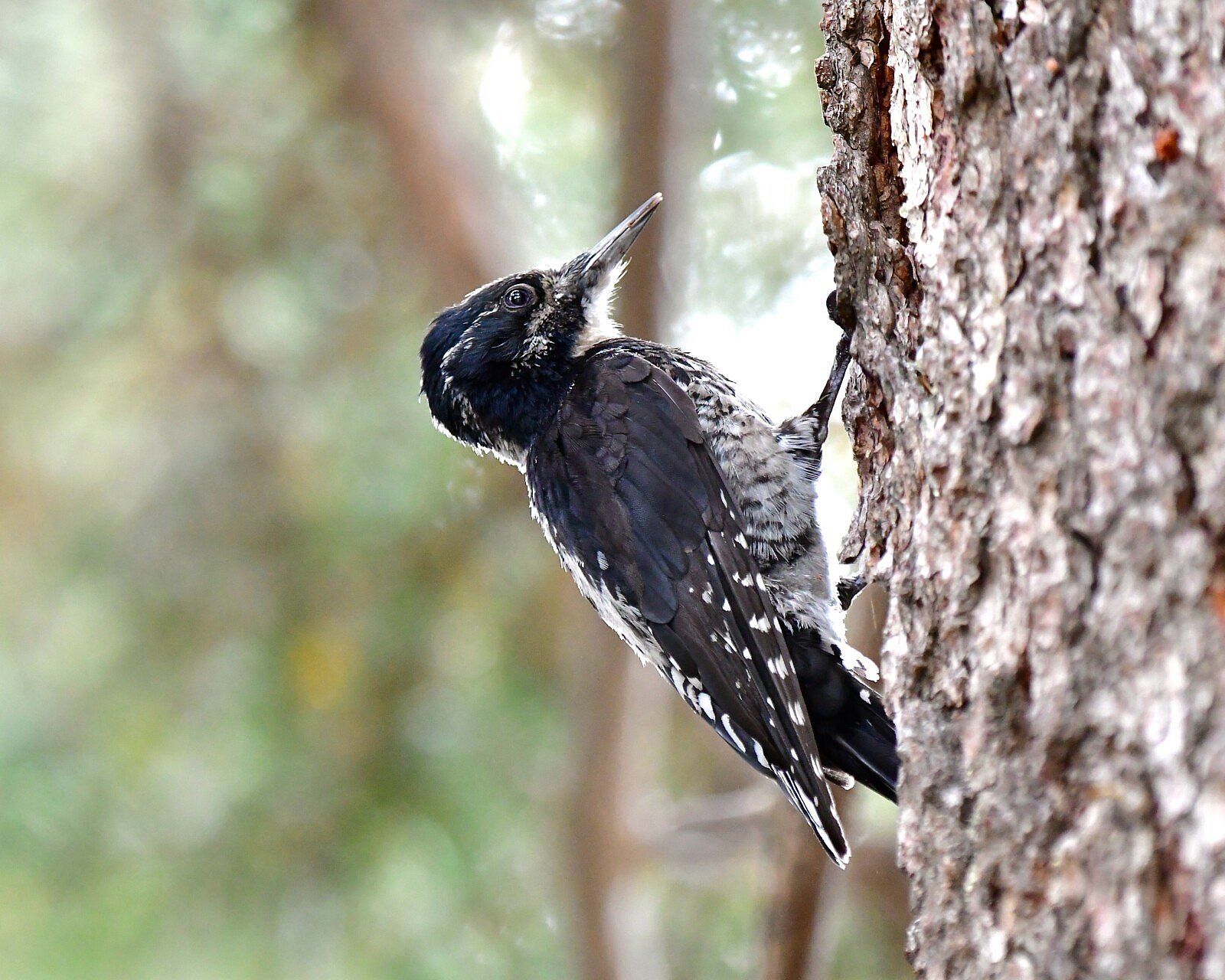
Black-backed Woodpecker
The Black-backed Woodpecker is another woodpecker with three toes. In fact, it looks very similar to the American Three-toed Woodpecker, but, as its name suggests, its back and head are entirely black except for a white stripe below its eye and a yellow crown.
This bird is also common in recently-burned forests, where individuals tend to blend in with the dark-colored trees. Like the Three-Toed, they find food beneath pieces of tree bark. Their diet consists mainly of wood-boring beetles and bark beetles. They help to manage the population of such insects, thus benefiting the area’s living trees.
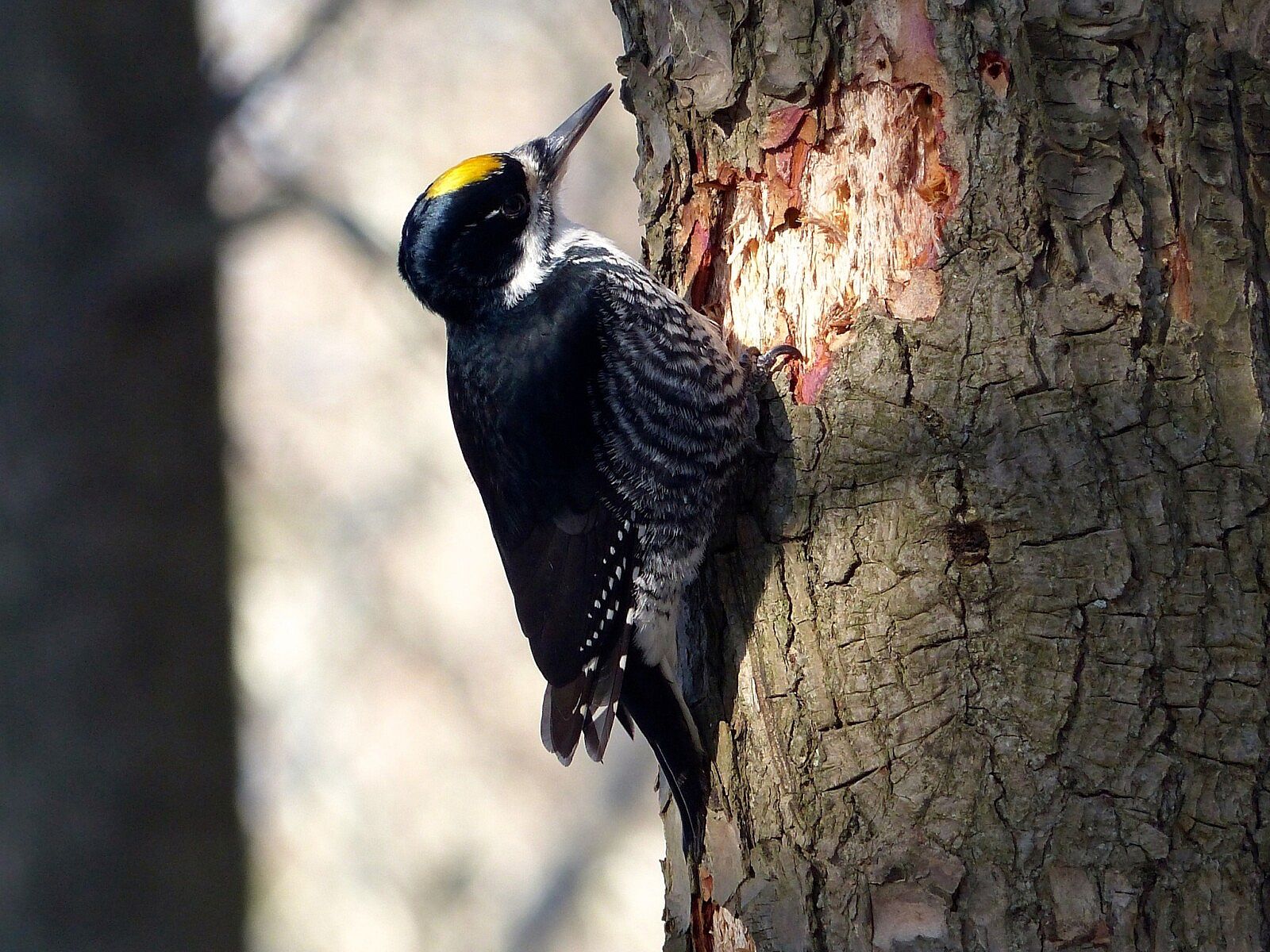
Lewis’s Woodpecker
The Lewis’s Woodpecker is unique in several ways. Rather than the boldly-patterned black and white plumage of many woodpeckers in the Greater Yellowstone Ecosystem, this bird has a dark and shiny green back, a pinkish belly, and a white chest. Its head is dark except for a red circle around the eye.
Like flycatchers, this species of woodpecker forages for insects in the air. It even shares the flycatcher’s behavior of waiting on a bare branch or other perch and returning to the same place after catching a bug. The Lewis’s Woodpecker is more consistently migratory than some other woodpecker species, only visiting Wyoming during the breeding season. Between 1968 and 2019, the population declined by about 48%.
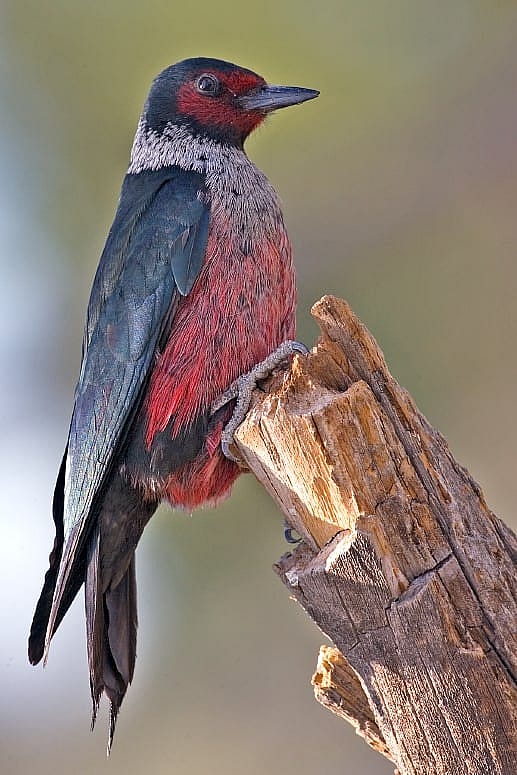
Red-naped Sapsucker
Red-naped Sapsuckers drill wells into various deciduous and some coniferous trees to feed on their sap. Originally thought to be a subspecies of the Yellow-bellied Sapsucker, it has the same bold black and white stripes and red throat and cap. What sets this sapsucker apart, of course, is the male’s red nape. On female Red-naped Sapsuckers, this patch on the back of the neck can be white or red, but the throat isn’t fully white like on a Yellow-bellied. In 2011, a banded Red-naped Sapsucker was recaptured in Wyoming, becoming the oldest recorded individual at over 4 years and 11 months.
While these birds can be found in mixed deciduous and coniferous forests, they usually stay near aspen, birch, and willow trees. After making their evenly spaced holes in a tree’s trunk, these birds will return to feed as the sap flows out. The small hairlike parts on the ends of their tongues hold sap, allowing them to sip from the trees. They also will eat insects and fruit.
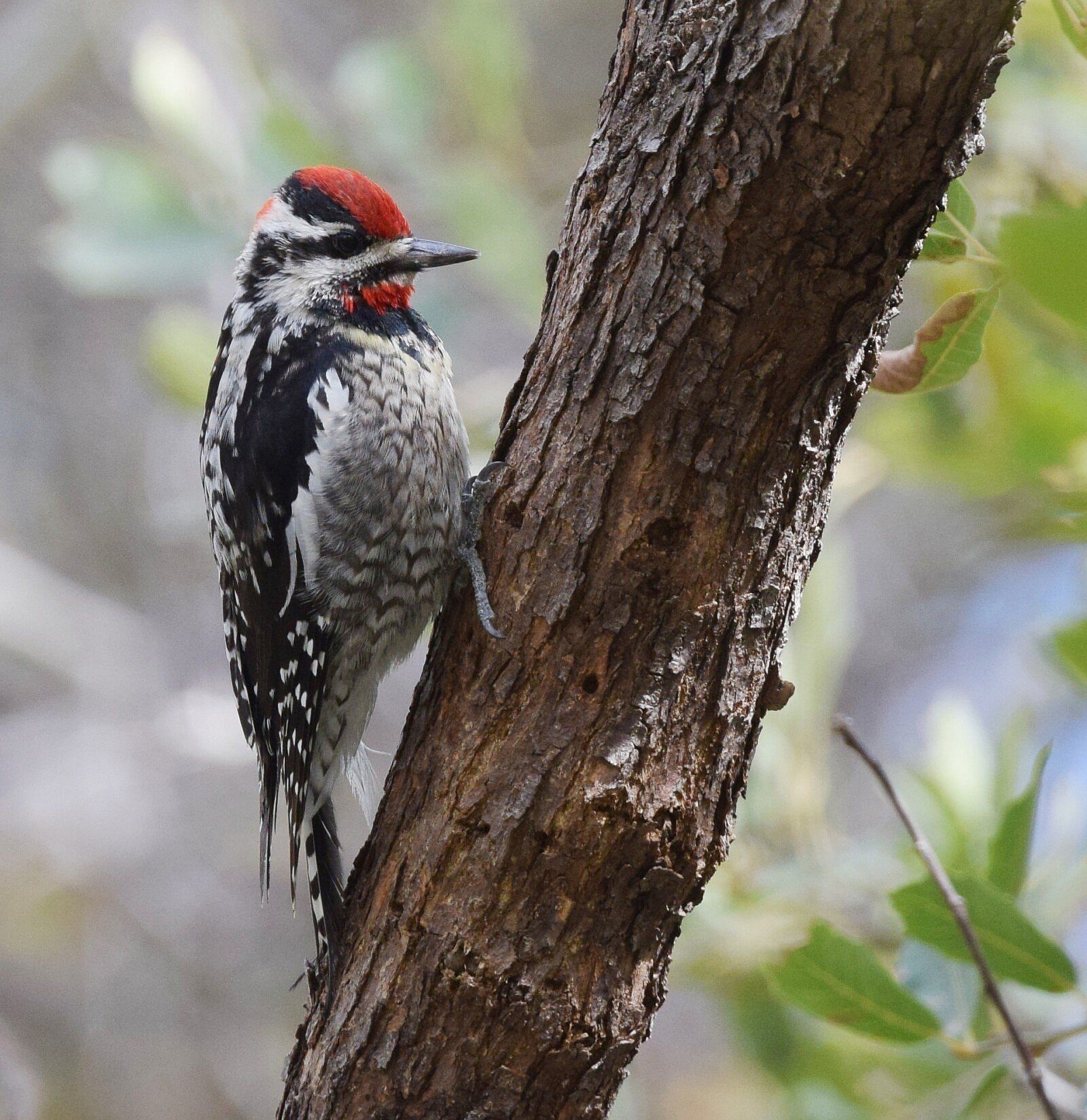
Williamson’s Sapsucker
The Williamson’s Sapsucker, rather than being combined with another species, was originally split into two different species because of the distinct variations between the male and female. The male has a unique yellow belly and red throat but is otherwise mostly black. It has white wing bars and face stripes. The female is overall light brown with black barring from nape to tail, but has a yellow belly and a black patch on the chest.
This sapsucker drills wells in coniferous trees. They also will feed on a variety of insects and other invertebrates in the spring and fruit and seeds in the colder months. Since conifers are their favorite trees on which to feed, this woodpecker is typically found in the pine, fir, and spruce forests of the high-elevation western mountains.
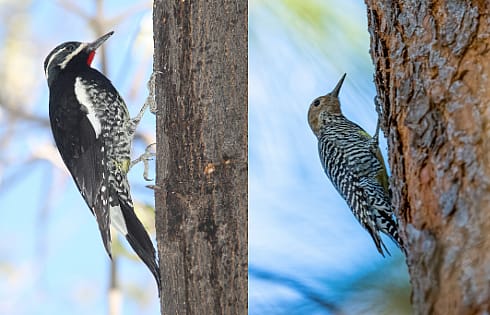
Right: “Williamson’s Sapsucker” photograph courtesy of Channel City Camera Club, Steve Colwell
Despite the fact that all of these species are closely related, they differ greatly in many ways. Woodpeckers are often inconspicuous and can be difficult to observe in their natural habitat. The Greater Yellowstone Ecosystem is a great place to get to know these unique birds.
Written By
Bliss Bonner
Bliss Bonner is the 2024 Curatorial Intern with the Draper Natural History Museum. Having lived near Yellowstone National Park and its surrounding ecosystems for her entire life, she has always been deeply interested in the natural world and plans to study science communication at the University of Wyoming. While Bliss loves to travel and see other parts of the world, she is equally passionate about what the Cody area offers. She spends much of her time exploring the mountains and looking for birds, and she also enjoys creative arts and writing.
